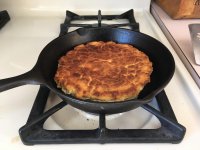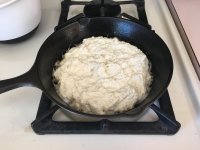- Joined
- Jun 22, 2016
- Messages
- 159
- Reaction score
- 7
Made some today for the first time (at home) and it came out pretty good. Of course there are many ways to make it according to one's preferences but I trying to figure out if it worth bringing/making in the first place. If you out for a 3-5 day trip in Fall/Winter/Spring do you bother? I get the impression it a more practical dish to make if one out for longer periods of time (weeks) since the basic ingredients flour, salt and b.s. (that's baking soda) won't go bad. Hey, if you like it, you like it...go ahead and make it but it seems to me there are less messes to be made with other foods. Ideally I only like to travel with a pot for boiling water only and a skillet for everything else. Your thoughts on simple prep/cleanup appreciated.
Attachments
Last edited:



